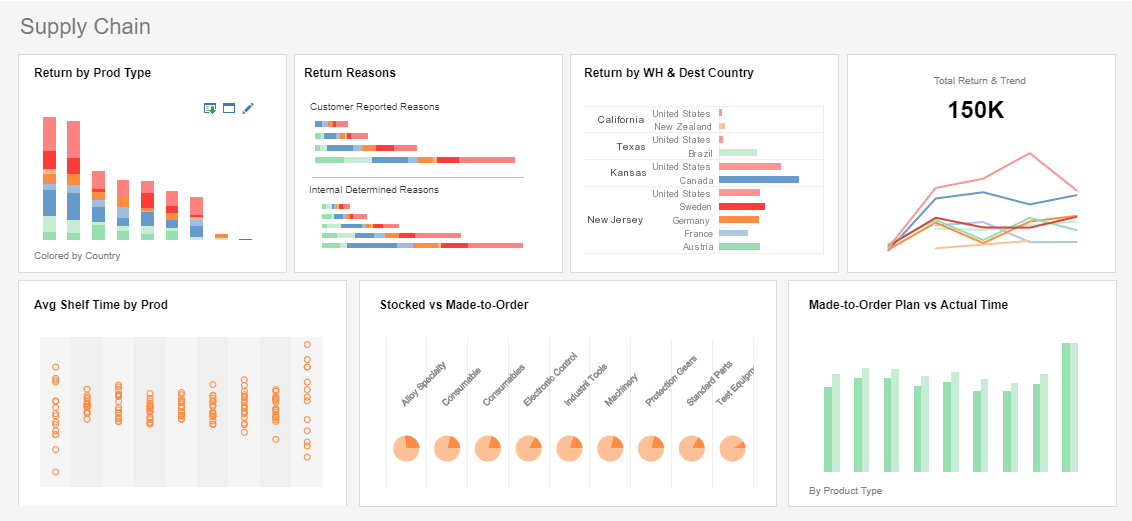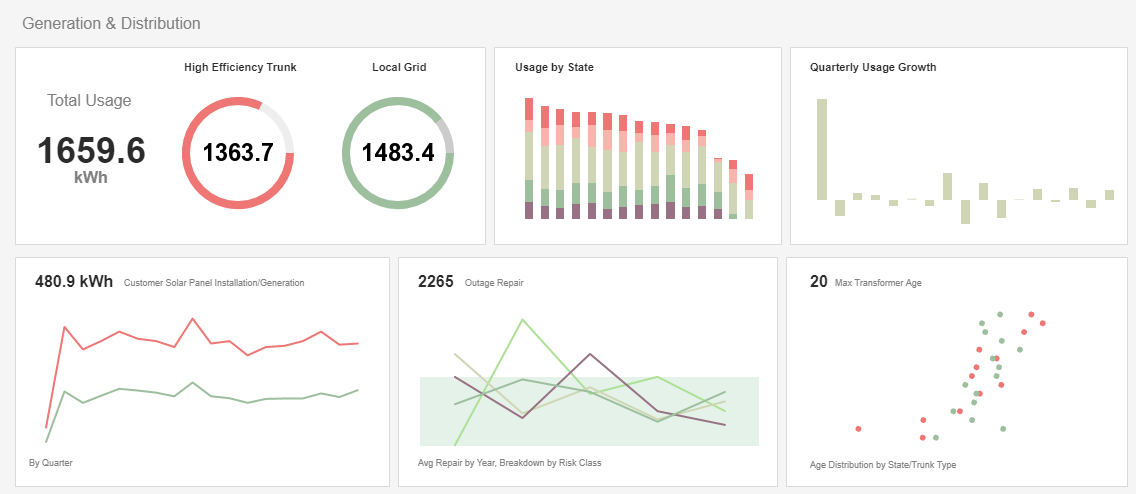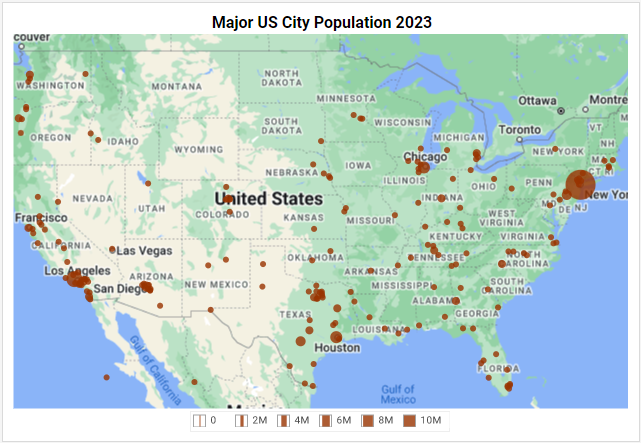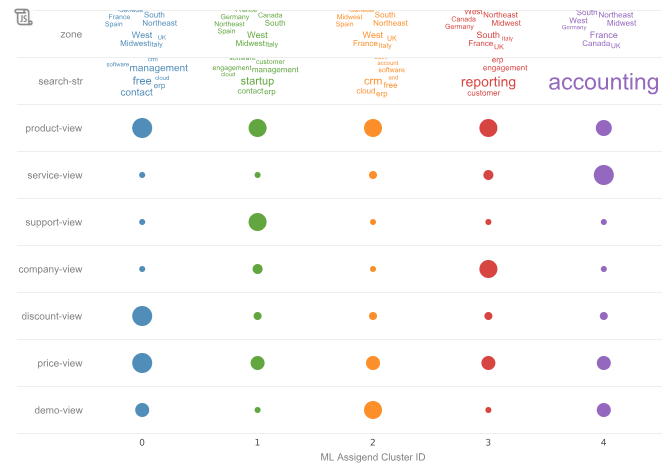Easy to Use Business Intelligence Tools
Are you searching for a Business Intelligence tool to help you make sense of your copious amounts of data? StyleBI, InetSoft's flagship BI application, can handle large amounts of data to help you identify and develop new opportunities.
StyleBI is an all-in-one tool for data mining, data mashup, reporting, and more. End users of all skill levels can take advantage of its intuitive point and click interface for answer ad hoc questions and exploring data.
Discovering Something New | Data Mining
Analyze trends, discover correlations, and explore what-if future scenarios
Through StyleBI, you can analyze your data from different perspectives, turning it from simple numbers to actionable information. The data mining process will help you focus on the most important information that queries and reports can sometimes miss.
Data mining with InetSoft is an easy, agile, and robust process that:
- is easy for analysts and administrators, requiring little to no SQL experience
- provides maximum self-service through ad hoc and visual analysis
- enables self-service at a data level through end user defined data mashup
- accommodates quick, formal, and/or experimental changes
- runs on a high-performance secure infrastructure
- makes machine learning accessible to business users
Taming Your Data Jungle | Enterprise Data Mashup
Combine disparate data sources to produce reports, dashboards, and new insights
When it comes to the subject of data mashup and easy to use business intelligence tools, InetSoft's focus is on the end user. The end user does not have any formal IT training or high-technological background. The average user sits in a cubicle, and it's InetSoft's goal to enable that person to build complex queries in a matter of seconds..
Through data mashup, end users can combine fields from various distinct data sources that were not previously modeled, import external data sources such as spreadsheets, and create new dashboards and/or reports to be shared in a BI environment.
InetSoft's data mashup engine allows these users to build these complex queries via a simple drag-and-drop interface. New data sources be be added quickly via direct connections to the operational data sources, bypassing the need for a data warehouse and experimentation before doing so.
Easy, Agile, Robust | Self-Service Reporting
Powerful data mashup for the creation of dashboards, visual analyses, and reports
Business users require flexibility when it comes to reporting. Like data mashup, creating reports must be an accessible process for both IT and business users, alike. InetSoft empowers both with a combination of powerful authoring tools and a highly scalable deployment environment.
InetSoft's easy to use business intelligence tool combines the familiar environment of a word-processor with dynamic data manipulation, enabling sophisticated reports to be created using simple-to-understand software.
In terms of reporting, StyleBI grants you access to:
- on demand, interactive reporting
- scheduling, bursting, archiving
- ad hoc querying
- and more...
What KPIs and Metrics Do Car Rental and Leasing Companies Track with BI Tools?
Car rental and leasing companies utilize Business Intelligence (BI) tools to track a variety of Key Performance Indicators (KPIs) and metrics to optimize operations, enhance customer satisfaction, and drive profitability. Here are some of the primary KPIs, their definitions, and their significance in performance management:
- Utilization Rate:
- Definition: The percentage of the fleet that is rented out at any given time.
- Significance: High utilization rates indicate effective fleet management and high demand for services, directly impacting revenue.
- Average Rental Duration:
- Definition: The average length of time a vehicle is rented.
- Significance: Helps in understanding customer behavior and planning fleet allocation to maximize revenue.
- Revenue per Unit (RPU):
- Definition: Total revenue generated divided by the number of vehicles in the fleet.
- Significance: Measures the profitability of each vehicle, guiding pricing strategies and fleet investment decisions.
- Customer Satisfaction Score (CSAT):
- Definition: A metric based on customer feedback that indicates their satisfaction with the rental or leasing experience.
- Significance: Reflects service quality and customer experience, which are critical for retention and brand reputation.
- Net Promoter Score (NPS):
- Definition: Measures customer loyalty and their likelihood of recommending the service to others.
- Significance: High NPS indicates strong customer loyalty, which can drive organic growth through referrals.
- Fleet Acquisition Cost:
- Definition: The total cost of acquiring new vehicles for the fleet.
- Significance: Important for budgeting and financial planning. Lower acquisition costs can improve profitability.
- Maintenance Cost per Vehicle:
- Definition: The average cost of maintaining each vehicle in the fleet.
- Significance: Helps in managing operating expenses and ensuring that vehicles are kept in good condition to maximize rental days.
- Damage Rate:
- Definition: The percentage of vehicles that sustain damage while rented.
- Significance: High damage rates can indicate issues with customer handling or fleet quality, impacting repair costs and vehicle availability.
- Turnaround Time:
- Definition: The time taken to prepare a vehicle for the next rental after it is returned.
- Significance: Shorter turnaround times mean higher fleet utilization and increased availability for customers.
- Booking Conversion Rate:
- Definition: The percentage of inquiries or visits to the website that result in actual bookings.
- Significance: Indicates the effectiveness of the company's sales and marketing efforts and the user experience of the booking process.
- Average Daily Rate (ADR):
- Definition: The average revenue earned per day for each rented vehicle.
- Significance: Measures pricing effectiveness and overall revenue generation capability.
- Operating Expense Ratio:
- Definition: The ratio of operating expenses to total revenue.
- Significance: Helps in evaluating the efficiency of the company's operations. A lower ratio indicates better cost management.
- Fleet Age:
- Definition: The average age of vehicles in the fleet.
- Significance: Younger fleets typically incur lower maintenance costs and offer better customer satisfaction due to newer models and features.
- Reservation Lead Time:
- Definition: The average time between when a reservation is made and the rental start date.
- Significance: Provides insights into customer planning behavior and helps in managing fleet availability.
- Customer Retention Rate:
- Definition: The percentage of customers who return for another rental or lease within a specified period.
- Significance: High retention rates indicate customer satisfaction and loyalty, which are crucial for long-term success.
- Market Share:
- Definition: The company's share of the total market sales or rentals in its segment.
- Significance: Indicates competitive positioning and overall market performance.
- Revenue Growth Rate:
- Definition: The percentage increase in revenue over a specific period.
- Significance: Measures the company's growth and effectiveness in expanding its customer base and services.
- Contract Renewal Rate:
- Definition: The percentage of lease contracts that are renewed at the end of their term.
- Significance: Indicates customer satisfaction and the attractiveness of leasing terms offered by the company.
- Fleet Turnover Rate:
- Definition: The rate at which vehicles are replaced or sold from the fleet.
- Significance: High turnover rates can indicate a strategy of maintaining a newer fleet, impacting customer satisfaction and maintenance costs.
- Online Booking Rate:
- Definition: The percentage of total bookings made through online channels.
- Significance: Reflects the effectiveness of the company's digital presence and the convenience offered to customers, which can enhance overall sales and customer engagement.
| #1 Ranking: Read how InetSoft was rated #1 for user adoption in G2's user survey-based index | Read More |
How Is Artificial Intelligence Used by Car Rental and Leasing Companies?
Artificial Intelligence (AI) is transforming the car rental and leasing industry by enhancing operational efficiency, improving customer experiences, and optimizing various business processes. Here are some key ways AI is being utilized by car rental and leasing companies:
1. Fleet Management and Optimization
- Predictive Maintenance: AI algorithms analyze vehicle data to predict when maintenance is needed, preventing breakdowns and reducing downtime. This helps in maintaining a healthy fleet and extending the life of vehicles.
- Dynamic Pricing: AI can adjust rental rates in real-time based on demand, availability, time of year, and competitor pricing, maximizing revenue and utilization rates.
- Route Optimization: For companies offering delivery and pick-up services, AI can optimize routes to reduce fuel consumption and improve delivery times.
2. Customer Experience Enhancement
- Personalized Recommendations: AI can analyze customer preferences and past rental history to offer personalized vehicle recommendations, increasing customer satisfaction and loyalty.
- Chatbots and Virtual Assistants: AI-powered chatbots provide instant customer support, handle booking inquiries, and assist with common issues, improving the efficiency of customer service and providing a seamless experience.
3. Fraud Detection and Prevention
- Anomaly Detection: AI systems can identify unusual patterns in booking and payment data, flagging potentially fraudulent transactions for further review. This helps in reducing financial losses and protecting customer data.
4. Operational Efficiency
- Automated Documentation: AI can automate the process of verifying and processing documents such as driver's licenses, insurance papers, and rental agreements, reducing manual workload and speeding up the rental process.
- Inventory Management: AI systems can predict demand and optimize the inventory of vehicles, ensuring that the right types of cars are available at the right locations to meet customer needs.
5. Customer Behavior Analysis
- Sentiment Analysis: AI can analyze customer feedback and reviews to gauge sentiment, identifying areas for improvement and enhancing service quality.
- Demand Forecasting: AI models can predict future demand based on historical data, seasonal trends, and external factors, allowing companies to better prepare and allocate resources.
6. Telematics and IoT Integration
- Real-Time Monitoring: AI-powered telematics systems provide real-time data on vehicle location, driving behavior, and performance metrics, enhancing security and allowing for better fleet management.
- Usage-Based Leasing: AI can enable usage-based leasing models where customers pay based on their actual usage, providing a more flexible and cost-effective solution for customers.
7. Marketing and Sales Optimization
- Targeted Advertising: AI analyzes customer data to create targeted marketing campaigns, improving the effectiveness of advertisements and increasing conversion rates.
- Lead Scoring: AI systems can score and prioritize sales leads based on their likelihood to convert, allowing sales teams to focus on the most promising opportunities.
8. Enhanced Security and Compliance
- Biometric Verification: AI can facilitate secure biometric verification processes, ensuring that only authorized individuals are renting vehicles and enhancing overall security.
- Regulatory Compliance: AI systems can monitor and ensure compliance with various local and international regulations, reducing the risk of legal issues.
9. Driver Behavior Analysis
- Safety Monitoring: AI analyzes driver behavior data to identify risky driving patterns, promoting safer driving habits and reducing accident rates.
- Insurance Optimization: Based on driving behavior analysis, AI can help in customizing insurance premiums, rewarding safe drivers with lower rates.
10. Sustainability Initiatives
- Carbon Footprint Reduction: AI can optimize fleet operations to reduce fuel consumption and emissions, contributing to sustainability goals.
- Electric Vehicle Management: AI systems can manage the charging schedules and usage patterns of electric vehicles to maximize efficiency and reduce operational costs.



